+in或on或at的区别
- 格式:doc
- 大小:80.00 KB
- 文档页数:13

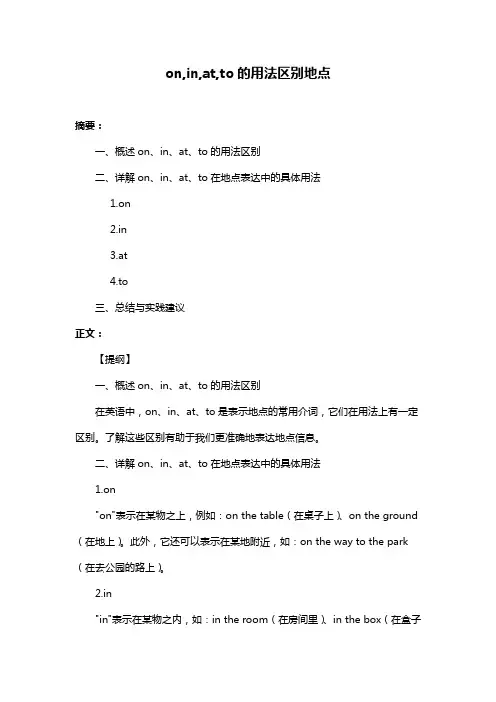
on,in,at,to的用法区别地点摘要:一、概述on、in、at、to的用法区别二、详解on、in、at、to在地点表达中的具体用法1.on2.in3.at4.to三、总结与实践建议正文:【提纲】一、概述on、in、at、to的用法区别在英语中,on、in、at、to是表示地点的常用介词,它们在用法上有一定区别。
了解这些区别有助于我们更准确地表达地点信息。
二、详解on、in、at、to在地点表达中的具体用法1.on"on"表示在某物之上,例如:on the table(在桌子上)、on the ground (在地上)。
此外,它还可以表示在某地附近,如:on the way to the park (在去公园的路上)。
2.in"in"表示在某物之内,如:in the room(在房间里)、in the box(在盒子里)。
它还可以表示在某地范围内,如:in the city(在城市里)。
3.at"at"表示在某地,如:at the library(在图书馆)、at the bus stop(在公交车站)。
它还可以表示在某地点附近,如:at the entrance(在入口处)。
4.to"to"表示到达某地,如:to the park(到公园)、to the supermarket (到超市)。
它还可以表示目的地,如:the airport is the destination to which we are going(机场是我们要去的目的地)。
三、总结与实践建议在实际应用中,我们要根据具体情况选择合适的介词。
了解on、in、at、to的用法区别,有助于提高我们的英语表达水平。
以下是一些实践建议:1.掌握各介词的基本含义和用法,避免在使用时产生歧义。
2.注意观察和学习英语母语者如何在不同场合使用这些介词。
3.多进行英语写作和口语练习,提高自己在地点表达方面的准确性。
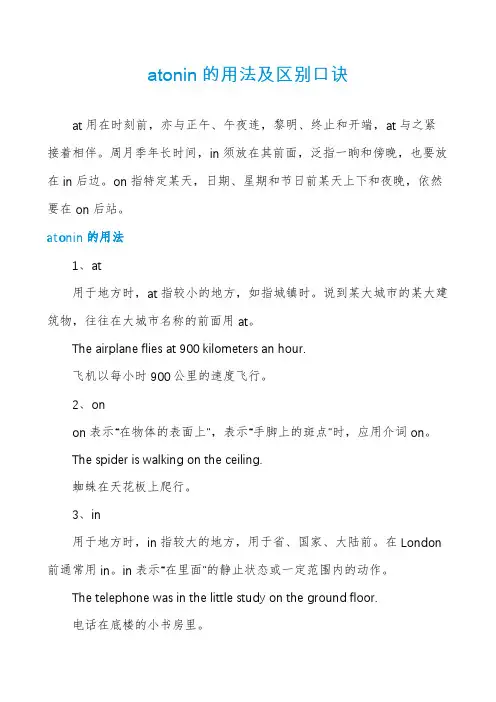
atonin的用法及区别口诀at用在时刻前,亦与正午、午夜连,黎明、终止和开端,at与之紧接着相伴。
周月季年长时间,in须放在其前面,泛指一晌和傍晚,也要放在in后边。
on指特定某天,日期、星期和节日前某天上下和夜晚,依然要在on后站。
atonin的用法1、at用于地方时,at指较小的地方,如指城镇时。
说到某大城市的某大建筑物,往往在大城市名称的前面用at。
The airplane flies at 900 kilometers an hour.飞机以每小时900公里的速度飞行。
2、onon表示“在物体的表面上”,表示“手脚上的斑点”时,应用介词on。
The spider is walking on the ceiling.蜘蛛在天花板上爬行。
3、in用于地方时,in指较大的地方,用于省、国家、大陆前。
在London 前通常用in。
in表示“在里面”的静止状态或一定范围内的动作。
The telephone was in the little study on the ground floor.电话在底楼的小书房里。
in at on记忆口诀分两阶段第一阶段:at+点时间,最小的时间就是几点几分,比如7:00-at seven,比如9:15-at a quarter past nineon+天时间,比点时间大就是哪一天,比如2008年8月8日-on August 8th, 2008,比如在星期一-on Mondayin+短时间,最大的时间,是指一个时间段,什么几天啦,几星期啦,几个月啊,几年啦,还有在春夏秋冬四个季度啦,比如in spring 第二阶段:(三长两短)“三长”指3个长单词(moring,afternoon,eveving),他们前面用in the,比如:in the morning,in the afternoon,in the evening “两短"指2个短单词(night,noon),他们前面用at,比如at noon,at night第三阶段:(“三长两短”被修饰)是指moring,afternoon,eveving,night,noon这5个单词,只要被修饰,不管是“星期一的早晨”,“晴朗的早晨”,总之被修饰了,都用on,比如on Monday morning,比如on a sunny morning。
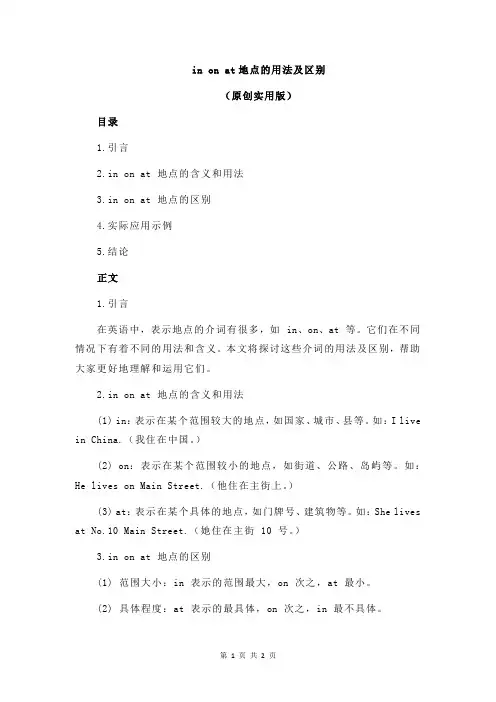
in on at地点的用法及区别(原创实用版)目录1.引言2.in on at 地点的含义和用法3.in on at 地点的区别4.实际应用示例5.结论正文1.引言在英语中,表示地点的介词有很多,如 in、on、at 等。
它们在不同情况下有着不同的用法和含义。
本文将探讨这些介词的用法及区别,帮助大家更好地理解和运用它们。
2.in on at 地点的含义和用法(1) in:表示在某个范围较大的地点,如国家、城市、县等。
如:I live in China.(我住在中国。
)(2) on:表示在某个范围较小的地点,如街道、公路、岛屿等。
如:He lives on Main Street.(他住在主街上。
)(3) at:表示在某个具体的地点,如门牌号、建筑物等。
如:She lives at No.10 Main Street.(她住在主街 10 号。
)3.in on at 地点的区别(1) 范围大小:in 表示的范围最大,on 次之,at 最小。
(2) 具体程度:at 表示的最具体,on 次之,in 最不具体。
(3) 是否可数:in 和 on 后跟可数名词单数或不可数名词,而 at 后跟可数名词单数。
4.实际应用示例(1) in:I will visit Japan in the summer vacation.(我将在暑假去日本旅行。
)(2) on:The plane landed on the runway.(飞机降落在跑道上。
)(3) at:We will have a meeting at the library.(我们将在图书馆举行会议。
)5.结论总之,在英语中,in、on、at 是表示地点的常用介词。
它们在用法和含义上有所区别,需要根据实际情况选择合适的介词。
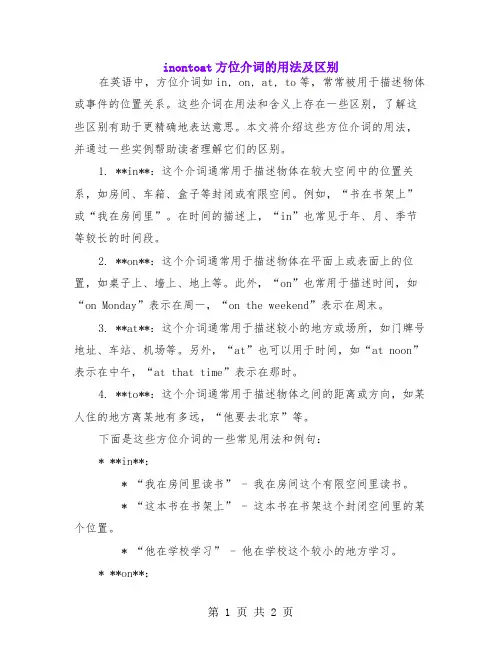
inontoat方位介词的用法及区别在英语中,方位介词如in, on, at, to等,常常被用于描述物体或事件的位置关系。
这些介词在用法和含义上存在一些区别,了解这些区别有助于更精确地表达意思。
本文将介绍这些方位介词的用法,并通过一些实例帮助读者理解它们的区别。
1. **in**:这个介词通常用于描述物体在较大空间中的位置关系,如房间、车箱、盒子等封闭或有限空间。
例如,“书在书架上”或“我在房间里”。
在时间的描述上,“in”也常见于年、月、季节等较长的时间段。
2. **on**:这个介词通常用于描述物体在平面上或表面上的位置,如桌子上、墙上、地上等。
此外,“on”也常用于描述时间,如“on Monday”表示在周一,“on the weekend”表示在周末。
3. **at**:这个介词通常用于描述较小的地方或场所,如门牌号地址、车站、机场等。
另外,“at”也可以用于时间,如“at noon”表示在中午,“at that time”表示在那时。
4. **to**:这个介词通常用于描述物体之间的距离或方向,如某人住的地方离某地有多远,“他要去北京”等。
下面是这些方位介词的一些常见用法和例句:* **in**:* “我在房间里读书” - 我在房间这个有限空间里读书。
* “这本书在书架上” - 这本书在书架这个封闭空间里的某个位置。
* “他在学校学习” - 他在学校这个较小的地方学习。
* **on**:* “请把书放在桌子上” - 请把书放在桌子这个平面上。
* “墙上挂着画” - 画挂在墙这个表面上。
* “她在周末看电视” - 她在周末的这个时间段看电视。
* **at**:* “我在家” - 我在家这个地方。
* “他在车站等车” - 他在这个车站等待车辆。
* “我们在周二开会” - 我们在这个星期二的某个时间开会。
* **to**:* “火车离这里还有五公里” - 火车离这里还有五公里的距离。
* “他要去北京工作” - 他要去北京这个目的地工作。
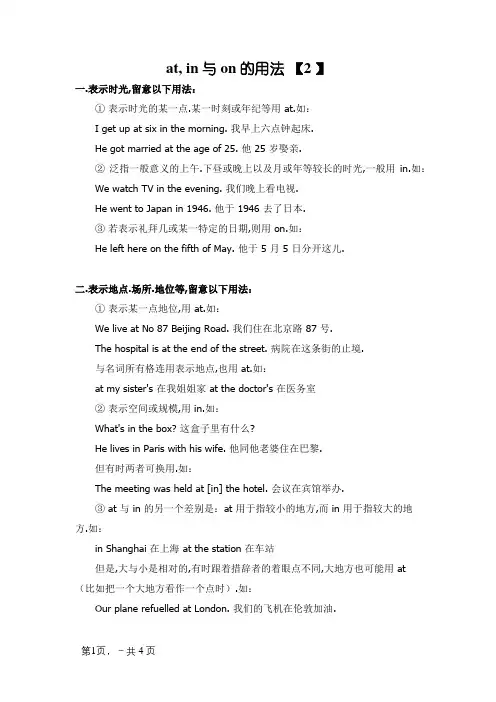
at, in与on的用法【2 】一.表示时光,留意以下用法:①表示时光的某一点.某一时刻或年纪等用 at.如:I get up at six in the morning. 我早上六点钟起床.He got married at the age of 25. 他 25 岁娶亲.②泛指一般意义的上午.下昼或晚上以及月或年等较长的时光,一般用in.如:We watch TV in the evening. 我们晚上看电视.He went to Japan in 1946. 他于 1946 去了日本.③若表示礼拜几或某一特定的日期,则用 on.如:He left here on the fifth of May. 他于 5 月 5 日分开这儿.二.表示地点.场所.地位等,留意以下用法:①表示某一点地位,用 at.如:We live at No 87 Beijing Road. 我们住在北京路 87 号.The hospital is at the end of the street. 病院在这条街的止境.与名词所有格连用表示地点,也用 at.如:at my sister's 在我姐姐家 at the doctor's 在医务室②表示空间或规模,用 in.如:What's in the box? 这盒子里有什么?He lives in Paris with his wife. 他同他老婆住在巴黎.但有时两者可换用.如:The meeting was held at [in] the hotel. 会议在宾馆举办.③ at 与 in 的另一个差别是:at 用于指较小的地方,而 in 用于指较大的地方.如:in Shanghai 在上海 at the station 在车站但是,大与小是相对的,有时跟着措辞者的着眼点不同,大地方也可能用 at(比如把一个大地方看作一个点时).如:Our plane refuelled at London. 我们的飞机在伦敦加油.We stopped for an hour at Moscow on our way to Paris. 我们在去巴黎的途中在莫斯科停了 1 个小时.④介词 on 用于地点,重要指在某物的表面.如:What's on the table? 桌上有什么?There's a wallet lying on the ground. 地上有个钱包.【注】在少数搭配中,也用介词 on.如:He works on a farm. 他在农场工作.三.在某些搭配中,三者的差别与英国英语和美国英语有关:in the street (英) / on the street (美) 在街上in the road (英) / on the road (美) 在路上in the team (英) / on the team (美) 在这个队at the weekend (英) / on the weekend (美) 在周末at weekends (英) / on weekends (美) 在周末四.有时三者的差别与搭配习惯和用法有关:in bed 在床上on the bed 在床上in the tree (多指树外之物) 在树上on the tree (多指树本身之物) 在树上at, in与on的差别一.in,on在方位名词前的差别1. in表示A地在B地规模之内.如: Taiwan is in the southeast of China.2. on表示A地与B地交界.邻接.如: North Korea is on the east of China.二.at, in, on在表示时光上的差别1. at指时光表示:(1)时光的一点.时刻等.如:They came home at sunrise (at noon, at midnight, at ten o’clock, at daybreak, at dawn).(2)较短暂的一段时光.可指某个节日或被以为是一年中标志大事的日子.如:He went home at Christmas (at New Year, at the Spring Festival, at night).2. in指时光表示:(1)在某个较长的时光(如世纪.朝代.年.月.季候以及泛指的上午.下昼或傍晚等)内.如:in 2004, in March, in spring, in the morning, in the evening, etc(2)在一段时光之后.一般情形下,用于未来时,谓语动词为刹时动词,意为“在……今后”.如:He will arrive in two hours.谓语动词为延续性动词时,in意为“在……以内”.如:These products will be produced in a month.留意:after用于未来时光也指一段时光之后,但厥后的时光是“一点”,而不是“一段”.如:He will arrive after two o’clock.3. on指时光表示:(1)具体的时日和一个特定的时光,如某日.某节日.礼拜几等.如:On Christmas Day(On May 4th), there will be a celebration.(2)在某个特定的凌晨.下昼或晚上.如:He arrived at 10 o’clock on the night of the 5th.(3)准时,按时.如:If the train should be on time, I should reach home before dark.三.at, in和on表示地点时的差别1. at表示地点:(1)用于指较小的地方.如: I shall wait for you at the station.(2)用于门商标码前.如: He lives at 115 Zhongshan Road.2. in表示地点:(1)用于指较大的地方.如:He lives in Shanghai.(2)固然是很小的地方,假如措辞人住在那边,也可用in.市肆.黉舍.机关等,若看作一个地点(point)用at,若看作一个场所(place)用in.如:I met him at the post-office.I’m now working in the post-office.3. on表示地点,一般指与面或线接触,意为“在……上;在……旁”.如:The picture was hanging on the wall.New York is on the Hudson River.。
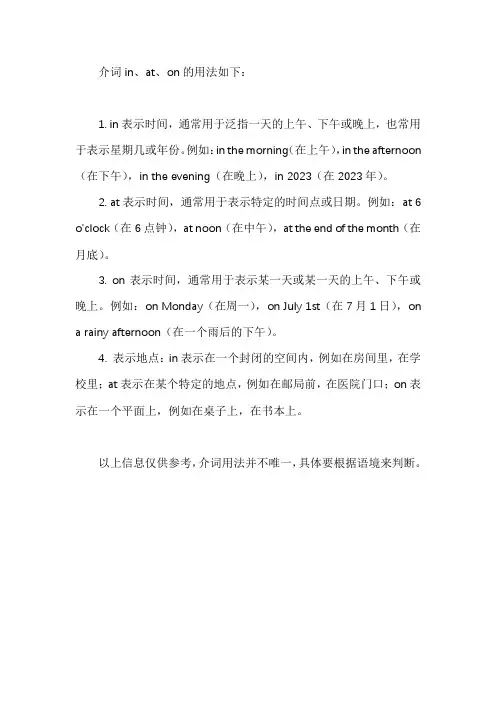
介词in、at、on的用法如下:
1. in表示时间,通常用于泛指一天的上午、下午或晚上,也常用于表示星期几或年份。
例如:in the morning(在上午),in the afternoon (在下午),in the evening(在晚上),in 2023(在2023年)。
2. at表示时间,通常用于表示特定的时间点或日期。
例如:at 6 o'clock(在6点钟),at noon(在中午),at the end of the month(在月底)。
3. on表示时间,通常用于表示某一天或某一天的上午、下午或晚上。
例如:on Monday(在周一),on July 1st(在7月1日),on
a rainy afternoon(在一个雨后的下午)。
4. 表示地点:in表示在一个封闭的空间内,例如在房间里,在学校里;at表示在某个特定的地点,例如在邮局前,在医院门口;on表示在一个平面上,例如在桌子上,在书本上。
以上信息仅供参考,介词用法并不唯一,具体要根据语境来判断。
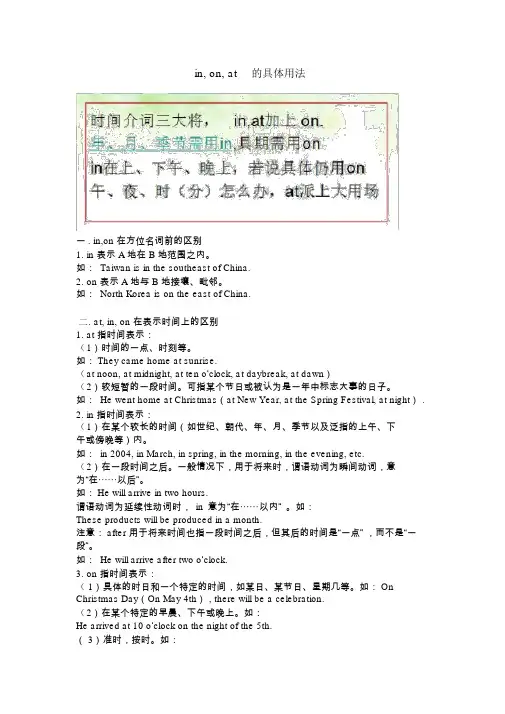
in, on, at的具体用法一 . in,on 在方位名词前的区别1.in 表示 A 地在 B 地范围之内。
如: Taiwan is in the southeast of China.2.on 表示 A 地与 B 地接壤、毗邻。
如: North Korea is on the east of China.二. at, in, on 在表示时间上的区别1.at 指时间表示:(1)时间的一点、时刻等。
如: They came home at sunrise.(at noon, at midnight, at ten o’clock, at daybreak, at dawn)(2)较短暂的一段时间。
可指某个节日或被认为是一年中标志大事的日子。
如: He went home at Christmas(at New Year, at the Spring Festival, at night) .2.in 指时间表示:(1)在某个较长的时间(如世纪、朝代、年、月、季节以及泛指的上午、下午或傍晚等)内。
如: in 2004, in March, in spring, in the morning, in the evening, etc.(2)在一段时间之后。
一般情况下,用于将来时,谓语动词为瞬间动词,意为“在⋯⋯以后”。
如: He will arrive in two hours.谓语动词为延续性动词时,in 意为“在⋯⋯以内”。
如:These products will be produced in a month.注意: after 用于将来时间也指一段时间之后,但其后的时间是“一点” ,而不是“一段”。
如: He will arrive after two o’clock.3.on 指时间表示:(1)具体的时日和一个特定的时间,如某日、某节日、星期几等。
如: On Christmas Day(On May 4th) , there will be a celebration.(2)在某个特定的早晨、下午或晚上。
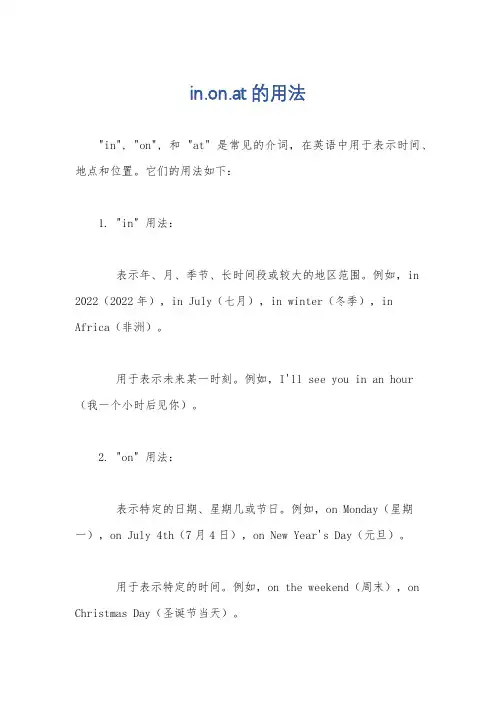
in.on.at的用法
"in", "on", 和 "at" 是常见的介词,在英语中用于表示时间、地点和位置。
它们的用法如下:
1. "in" 用法:
表示年、月、季节、长时间段或较大的地区范围。
例如,in 2022(2022年),in July(七月),in winter(冬季),in Africa(非洲)。
用于表示未来某一时刻。
例如,I'll see you in an hour (我一个小时后见你)。
2. "on" 用法:
表示特定的日期、星期几或节日。
例如,on Monday(星期一),on July 4th(7月4日),on New Year's Day(元旦)。
用于表示特定的时间。
例如,on the weekend(周末),on Christmas Day(圣诞节当天)。
3. "at" 用法:
表示具体的时间。
例如,at 3 o'clock(3点钟),at noon(中午),at midnight(午夜)。
用于表示特定的地点或位置。
例如,at the bus stop(在公交车站),at the door(在门口)。
需要注意的是,这些介词的使用有时候是固定搭配,需要根据具体语境来判断。
希望这些解释能帮助你更好地理解它们的用法。
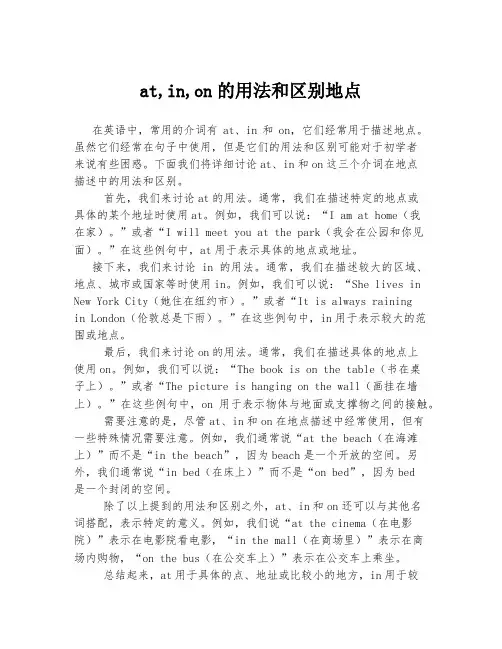
at,in,on的用法和区别地点在英语中,常用的介词有at、in和on,它们经常用于描述地点。
虽然它们经常在句子中使用,但是它们的用法和区别可能对于初学者来说有些困惑。
下面我们将详细讨论at、in和on这三个介词在地点描述中的用法和区别。
首先,我们来讨论at的用法。
通常,我们在描述特定的地点或具体的某个地址时使用at。
例如,我们可以说:“I am at home(我在家)。
”或者“I will meet you at the park(我会在公园和你见面)。
”在这些例句中,at用于表示具体的地点或地址。
接下来,我们来讨论in的用法。
通常,我们在描述较大的区域、地点、城市或国家等时使用in。
例如,我们可以说:“She lives in New York City(她住在纽约市)。
”或者“It is always rainingin London(伦敦总是下雨)。
”在这些例句中,in用于表示较大的范围或地点。
最后,我们来讨论on的用法。
通常,我们在描述具体的地点上使用on。
例如,我们可以说:“The book is on the table(书在桌子上)。
”或者“The picture is hanging on the wall(画挂在墙上)。
”在这些例句中,on用于表示物体与地面或支撑物之间的接触。
需要注意的是,尽管at、in和on在地点描述中经常使用,但有一些特殊情况需要注意。
例如,我们通常说“at the beach(在海滩上)”而不是“in the beach”,因为beach是一个开放的空间。
另外,我们通常说“in bed(在床上)”而不是“on bed”,因为bed是一个封闭的空间。
除了以上提到的用法和区别之外,at、in和on还可以与其他名词搭配,表示特定的意义。
例如,我们说“at the cinema(在电影院)”表示在电影院看电影,“in the mall(在商场里)”表示在商场内购物,“on the bus(在公交车上)”表示在公交车上乘坐。

1. 表示,注意用法:(1) 表示的某一点、某一时刻或年龄等用at。
如:I get up at six in the morning. 我早上六点钟起床。
He got married at the age of 25. 他25 岁结婚。
(2) 泛指意义的上午、下午或晚上月或年等较长的,用in。
如:We watch TV in the evening. 晚上看电视。
He went to Japan in 1946. 他于1946 去了日本。
(3) 若表示星期几或某一特定的日期,则用on。
如:He left here on the fifth of May. 他于5 月5 日离开这儿。
2. 表示地点、场所、位置等,注意用法:(1) 表示某一点位置,用at。
如:We live at No 87 Beijing Road. 住在北京路87 号。
The hospital is at the end of the street. 医院条街的尽头。
与名词所有格连用表示地点,也用at。
如:at my sister’s 在我姐姐家at the doctor’s 在医务室(2) 表示空间或范围,用in。
如:What’s in the box? 这盒子里有?He lives in Paris with his wife. 他同他妻子住在巴黎。
但有时两者可换用。
如:The meeting was held at [in] the hotel. 会议在宾馆举行。
(3) at 与in 的另区别是:at 用于指较小的地方,而in 用于指的地方。
如:in Shanghai 在上海at the station 在车站,大与小是的,有时说话者的着眼点不同,大地方也用at(比如把大地方看作点时)。
如:Our plane refuelled at London. 的飞机在伦敦加油。
We stopped for an hour at Moscow on our way to Paris. 在去巴黎的途中在莫斯科停了1 个小时。
介词at,in与on的用法与区别介词 at,in 与 on 的用法与区别介词在英语中起着重要的作用,它们能够帮助我们更准确地表达时间、地点和其他相关的概念。
在众多介词中,at、in 和 on 是使用频率较高的三个,但其用法和区别常常让学习者感到困惑。
接下来,让我们详细探讨一下它们的具体用法和区别。
一、at 的用法1、表示具体的时间点“at”通常用于表示具体的时间点,例如:at six o'clock(在六点钟)、at noon(在中午)、at midnight(在午夜)。
2、表示特定的时刻或短暂的瞬间at the moment(此刻)、at that time(那时)、at the beginning/end (在开始/结束时)。
3、表示某个具体的场所或地点at the bus stop(在公交车站)、at the airport(在机场)、at the door (在门口)。
二、in 的用法1、表示较长的时间段in the morning/afternoon/evening(在上午/下午/晚上)、in May(在五月)、in 2023(在 2023 年)、in summer/winter(在夏天/冬天)。
2、表示在某个较大的空间或范围之内in the city(在城市里)、in the country(在乡村)、in the room(在房间里)。
三、on 的用法1、表示具体的日期on Monday(在星期一)、on May 1st(在五月一日)、on Christmas Day(在圣诞节)。
2、表示在某一天或某一天的上午、下午、晚上on Sunday morning(在星期天上午)、on the evening of June 1st (在六月一日的晚上)。
3、表示在某个表面上on the table(在桌子上)、on the wall(在墙上)。
四、at,in 与 on 在时间表达上的区别1、时间点用“at”例如:“at 7:30”(在七点半),“at dawn”(在黎明)。
in on at地点的用法及区别摘要:一、地点介词in、on和at的用法概述1.in:表示在某范围内,如城市、国家、房间等2.on:表示在某物上方或表面,如地图、时间、街道等3.at:表示在某点或位置,如公园、车站、聚会等二、地点介词in、on和at的区别1.范围与位置的区别2.表面与内部的区分3.具体与抽象的表达三、实例解析1.在城市里(in the city)2.在公园里(in the park)3.在火车上(on the train)4.地图上的位置(on the map)5.聚会地点(at the party)6.车站附近(at the station)四、总结与实践1.了解介词in、on和at的基本用法2.掌握它们在不同场景下的区别3.提高英语表达的准确性和地道性正文:在英语中,地点介词in、on和at的用法及区别是英语学习者在日常生活中必须掌握的基本知识。
它们分别表示在不同范围、位置和表面的概念,从而帮助我们更准确地描述事物之间的关系。
首先,让我们了解一下这三个介词的基本用法。
当我们说“在某范围内”时,我们可以使用介词in。
例如,“in the city”表示“在城市里”,“in the room”表示“在房间里”。
相反,如果我们要表达“在某物上方或表面”,我们应使用介词on。
如:“on the map”表示“在地图上”,“on the table”表示“在桌子上”。
而介词at则用于表示某个具体的点或位置,如“at the park”(在公园里)、“at the station”(在车站附近)。
尽管in、on和at都表示地点,但它们之间存在一定的区别。
首先,in和at主要区别在于范围。
in表示在某范围内,如国家、城市、房间等;而at表示在某点或位置,如公园、车站、聚会等。
其次,on和at的区别在于表面。
on表示在某物表面,如地图、时间等;at表示在某点,但没有强调表面。
此外,in、on和at还用于表示具体与抽象的概念。
介词at,in与on的用法与区别在英语学习中,介词的正确使用往往是一个难点。
其中,at、in 和on 这三个介词更是频繁出现,它们的用法多样,且存在一定的区别。
下面我们就来详细探讨一下这三个介词的用法与区别。
一、at 的用法1、表示时间“at”用于表示具体的时刻或较短的时间段。
例如:“at six o'clock”(在六点钟)、“at noon”(在中午)、“at night”(在晚上)。
需要注意的是,“at night”是一个固定搭配,而如果要表示在特定的某个晚上,比如“在周五晚上”,则要用“on Friday night”。
2、表示地点“at”用于表示较小的地点,比如“at the bus stop”(在公交车站)、“at the school gate”(在校门口)、“at home”(在家)。
3、表示活动常见的有“at work”(在工作)、“at school”(在学校)、“at the party”(在派对上)。
二、in 的用法1、表示时间“in”用于表示较长的时间段,比如“in the morning”(在早上)、“in May”(在五月)、“in 2023”(在 2023 年)、“in the 21st century”(在21 世纪)。
2、表示地点“in”用于表示较大的地点,比如“in Beijing”(在北京)、“in China”(在中国)、“in the city”(在城市里)。
3、表示状态或情况例如“in trouble”(处于困境中)、“in danger”(处于危险中)。
三、on 的用法1、表示时间“on”用于表示具体的日期、星期几或特定的某一天的上午、下午或晚上。
比如“on Monday”(在星期一)、“on May 1st”(在五月一日)、“on the morning of June 6th”(在六月六日的早上)。
2、表示位置“on”表示在上面,且与表面有接触,例如“on the table”(在桌子上)、“on the wall”(在墙上)。
atonin的用法及区别表示时间的某一点、某一时刻或年龄等用at;泛指一般意义的上午、下午或晚上以及月或年等较长的时间,一般用in;若表示星期几或某一特定的日期,则用on等。
1.in表示A地在B地范围之内。
如:Taiwan is in the southeast of China.2.on表示A地与B地接壤、毗邻。
如:North Korea is on the east of China.1.at指时间表示:(1)时间的一点、时刻等。
如:They came home at sunrise (at noon,at midnight,at ten o’clock,at daybreak,at dawn).(2)较短暂的一段时间。
可指某个节日或被认为是一年中标志大事的日子。
如:He went home at Christmas (at New Year,at the Spring Festival,at night).2.in指时间表示:(1)在某个较长的时间(如世纪、朝代、年、月、季节以及泛指的上午、下午或傍晚等)内。
如:in 2021, in March。
(2)在一段时间之后。
一般情况下,用于将来时,谓语动词为瞬间动词,意为“在……以后”。
如:He will arrive in two hours.谓语动词为延续性动词时,in意为“在……以内”。
如:These products will be produced in a month.注意:after用于将来时间也指一段时间之后,但其后的时间是“一点”,而不是“一段”。
如:He will arrive after two o’clock.3.on指时间表示:(1)具体的时日和一个特定的时间,如某日、某节日、星期几等。
如:On Christmas Day(On May 4th),there will be a celebration.(2)在某个特定的早晨、下午或晚上。
一. in,on 在方向名词前的差别1.in 表示 A 地在 B 地范以内。
如:Taiwan is in the southeast of China.2.on 表示 A 地与 B 地接壤、毗。
如:North Korea is on the east of China.※二 . at, in, on在表示时间上的差别1.at 指表示:(1)的一点、刻等。
如:They came home at sunrise(at noon, at midnight, at ten o, at’clock daybreak, at dawn ).(2)短的一段。
可指某个日或被是一年中志大事的日子。
如:He went home at Christmas(at New Year, at the Spring Festival,at night ) .2.in 指表示:(1)在某个的(如世、朝代、年、月、季以及泛指的上午、下午或夜晚等)内。
如:in 2004, in March, in spring, in the morning, in the evening, etc(2)在一段以后。
一般状况下,用于未来,瞬,意“在⋯⋯此后”。
如:He will arrive in two hours.延性,in 意“在⋯⋯以内”。
如:These products will be produced in a month.注意:after 用于未来时间也指一段时间以后,但后来的时间是“一点”,而不是“一段”。
如:He will arrive after two o’clock.3.on 指时间表示:(1)详细的时间和一个特定的时间,如某日、某节日、礼拜几等。
如:On Christmas Day(On May 4th), there will be a celebration.(2)在某个特定的清晨、下午或夜晚。
如:He arrived at 10 o’clock on the night of the 5th.(3)准时,准时。
“in”、“on”和“at”这三个介词在英语中都有表示时间或位置的用法,以下是它们的用法汇总:
1.“in”的用法:
•表示时间:在某个时间段内,如“in 2023”(在2023年),“in the morning”
(在上午)。
•表示位置:在一个较大的区域内,如“in China”(在中国),“in the city”
(在城市里)。
2.“on”的用法:
•表示时间:在某一天或某一天的上午或下午,如“on Sunday”(在星期天),“on the morning of June 1st”(在6月1日上午)。
•表示位置:在某个物体的表面或与其接触的平面上,如“on the table”(在桌子上),“on the ground”(在地上)。
3.“at”的用法:
•表示时间:在具体的时间点,如“at 5 o’clock”(在5点钟),“at noon”(在中午)。
•表示位置:在一个具体的点或小区域内,如“at the corner of the street”
(在街道拐角处),“at the entrance”(在入口处)。
以上只是这三个介词的一般用法,它们的实际用法可能会根据语境和习惯而有所不同。
介词in,on与at用于表示时间的名词前用法各不相同介词in,on与at都可用于表示时间的名词前,但用法各不相同,其区别在于:一、用in的场合(1)表示“在某年/月/季节”这个含义时,须用介词in。
例如:She came to this city in 1980.他于1980年来到这个城市。
It often rains here in summer.夏天这里常常下雨。
(2)表示“从现在起一段时间以后”时,须用介词in。
例如:They will go to see you in a week.他们将在一周后去看望你。
I will be back in a month.我将在一个月后回来。
(3)表示“在某世纪”时,须用介词in.例如:This machine was invented in the eighteenth century.这台机器是在18世纪发明的.Great changes took place in the twentieth century.20世纪发生了巨大变化.(4)表示“在某年代或特定世纪某年代”时,须用介词in。
例如:This incident happened in the 1970''''s.该事件发生在20世纪70年代。
The Anti-Japanese War broke out in the 1930''''s.抗日战争爆发于20世纪30年代。
除此之外,morning / evening / afternoon 三个词也常跟介词in连用。
例如:Don't watch TV too much in the evening.晚上看电视不要太多。
They sometimes play games in the afternoon.他们有时在下午做游戏。
二、用on的场合(1)表示“在具体的某一天”或“(在具体的某一天的)早上、中午、晚上”等,须用介词on。
例如:Jack was born on May 10th,1982.杰克生于1982年5月10日。
They left on a rainy morning.他们是在一个雨天的早上离开的。
He went back to America on a summer afternoon.他于一个夏天的下午返回了美国。
(2)表示“在星期几”或“在星期几的早上、中午、晚上”等,须用介词on。
例如:We don't go to school on Saturday and Sunday.我们星期六和星期天不上学。
What time do you get up on weekdays?你在平日什么时候起床?I heard this story on Saturday morning.我是在星期六的早晨听到这个故事的。
(3)表示“在某一节日”时,须用介词on。
例如:We usually eat mooncakes on Mid-autumn Festival.我们通常在中秋节吃月饼。
Mr Hu received a card on Teachers''''Day.胡老师在教师节那天收到了一张卡片。
注意:当morning,evening,afternoon被of短语修饰,习惯上用in,而不用on.例如:in the early morning of September 10th 在9月10的清晨;in the late afternoon of September 12th 在9月12日的傍晚。
三、用at的场合(1)表示“某一具体时刻(即几点几分时)”,须用介词at。
例如:He gets up at six o''''clock every day .他每天六点起床。
I got home at five thirty yesterday afternoon.我昨天下午五点半到家。
(2)用在特定的时候(时节、时机)时,须用介词at。
例如:They were happy at that time.他们那时很幸福。
I think the shop is clcsed at this time of day.我认为商店在白天的这个时候关门了。
(3)表示“在中午、在夜晚、在周末”时,须用介词at。
例如:What do you often do at noon?你中午经常做些什么?You can see many stars in the sky at night.夜晚你能看到天空中有许多星星。
(4)表示“在……岁”时,须用介词at。
例如:At the age of nine ,the boy could swim well.在九岁的时候,这孩子就游泳游得很好了。
At the age of twenty,I began to teach English at this school.在二十岁的时候,我就开始在这所学校教英语了。
注意:在含有next ,last,this,one ,any, each, every , some, all的词组和tomorrow,yesterday, the day after tomorrow, the day before yesterday 前不用任何介词。
例如:What did you do last summer holidays?去年暑假你做了些什么?What are you going to do the day after tomorrow?后天你打算做什么?一、不定式符号to的省略形式1、在疑问副词why或why not后常直接用不带to的不定式构成问句。
如:Why not try again?为什么不再试一下?2、在某些介词后可以接不带to的不定式形式。
1)在“can’t but...不得不,只好”之后。
I can not but admire his courage。
我不得不佩的勇气。
2)在“can but...只能,大不了”之后I can but lose that money。
我大不了丢掉那笔钱。
3)在“do nothing but(or.except)...,there be sth.to do but(or except)...,sb.have sth.to do but”等结构中,介词,but(or except)后用不带to的动词不定形式。
He did nothing at the meeting but smoke.他在会上什么也没干只是吸烟。
I have nothing to do except copy the artecle for hi m.我只好给他抄写这篇文章。
3、在固定句式结构中的副词后接不带to的不定式。
1) had better/had best最好You'd better tell her about it.你最好把这件事告诉她。
2) would rather(not)...宁可(不);宁愿(不)=would sooner(not )...I would rather not tell you.我宁可不告诉你。
此句型也可以扩展成:would rather...than...=would...rather tha n...或would sooner...than宁可......也不......。
如:He would rat her die than give in to the enemy.他宁死也不向敌人屈服。
4、在祈使语气(或口语)中,在动词come,go,run后接不定式作目的状语可省略不定式符号to,这一点在美国英语中常见,其用法常见于祈使句。
如:Go see what's going to outside.去看看外边发生了什么事。
5、一般在助动词或情态动词如:do,will,shall,would,should,can,may,m ust等后面接不带to的动词不定式。
如:Do you still remember what your tea cher told you the other day?你还记得前两天你们老师跟你讲的事吗?6、在视觉性动词see,watch,notice,observe,note等,听觉性动词hear,使役性动词make,let,have,感性动词feel等动词后接不定式作复合宾语时,不定式不带to,但省略to的不式作主语补主语时,则需加上to,这时不能省略不定式符号to。
如:Suddenly we felt the at mosphere grow tense.突然我们感到气氛变得紧张起来。
He was made to do it again.他被迫再做一遍。
7、并的两个或多个带to的不定式由并列式连词and或or连接在一起,在句中作表语、宾语、或状语等时,第二个及其后的不定式符号可省略。
如:She told her child to stay there and w ait till she came back.她告诉好的孩子呆在那儿一直等到她回来。
8、在词组look at和listen to后的“宾语+不定式”结构中也用不带to的不定式形式。
在美国英语中常见。
如:She listened to the rain patter on the window-p anes.她倾听着雨水敲打着玻璃窗。
不定式省略to的九种情况一、使役动词后省略to的情况在let, make, have等使役动词后用作宾语补足语的不定式必须省略to等使役动词后用作宾语补足语的不定式必须省略to。
如:My mother wouldn’t let me go to the film. 我妈妈不会让我去看电影的。
I don’t like milk, but mother made me drink it. 我不喜欢牛奶,可是母亲强迫我喝。
I would have him wait for me at the gate of the park. 我要他在公园门口等我。
注意:1. 当使役动词用于被动语态时,要补上在主动语态中省略的to(主要是指make,let和have很少用于被动语态)。
2. force, oblige等虽然也表示“使”,但它们后用作宾语补足语的不定式必须带to。
如:He forced me to go with them. 他迫使我同他们一起去。
The police obliged him to leave. 警方强迫他离开。
二、感觉动词后省略to的情况在感觉动词后用作宾语补足语的不定式必须省略to在感觉E: 10.5pt;mso-ascii-font-family: 'Times New Roman'; mso-bidi-font-family: 'Times New Roman'">。